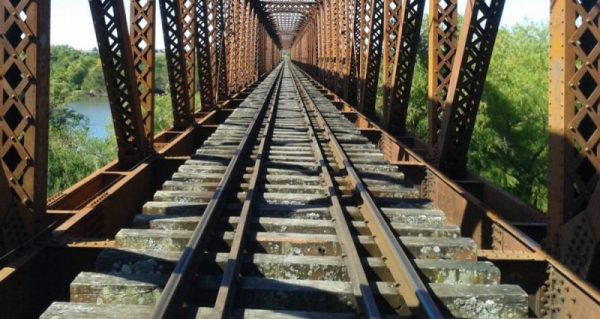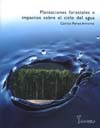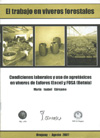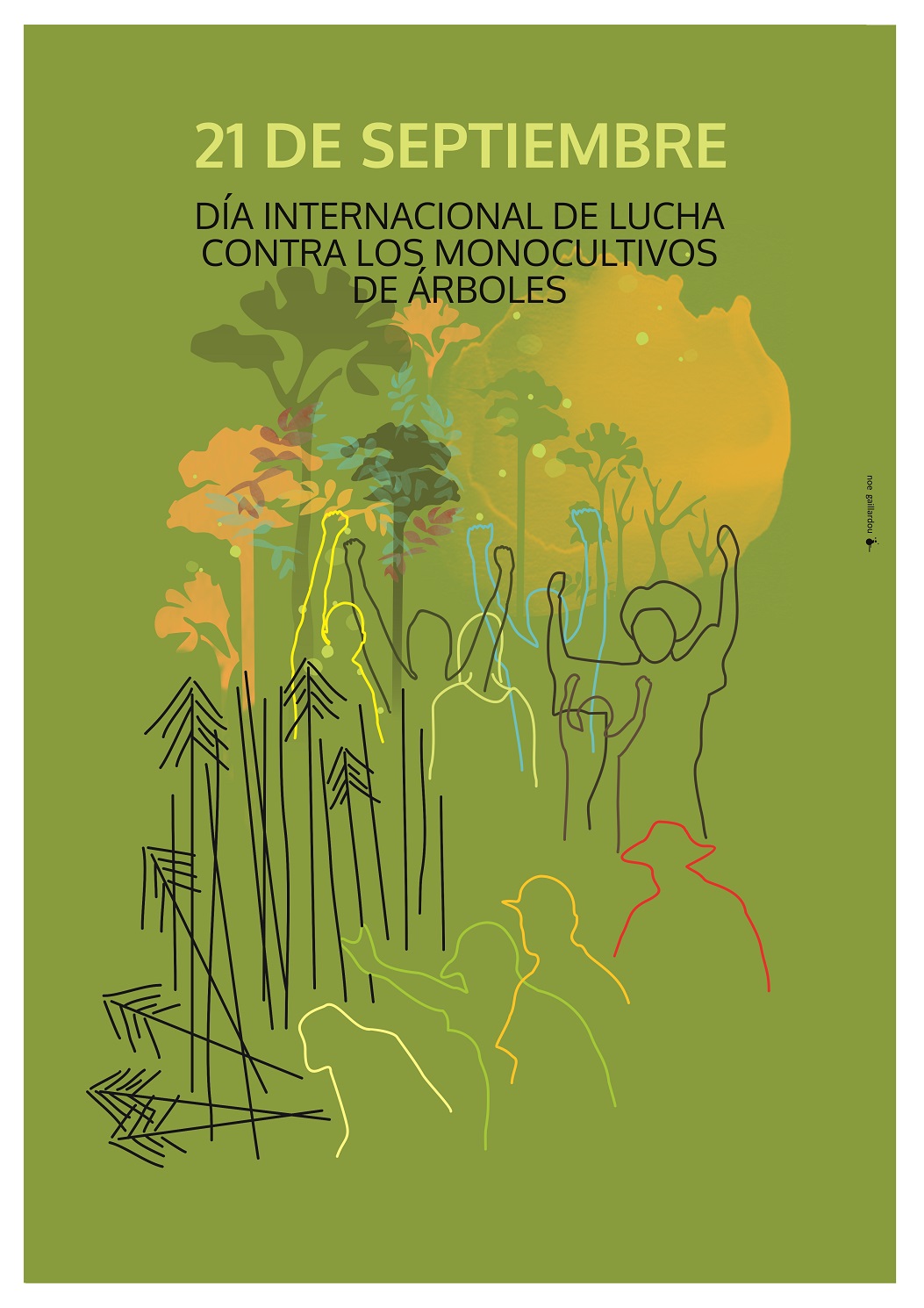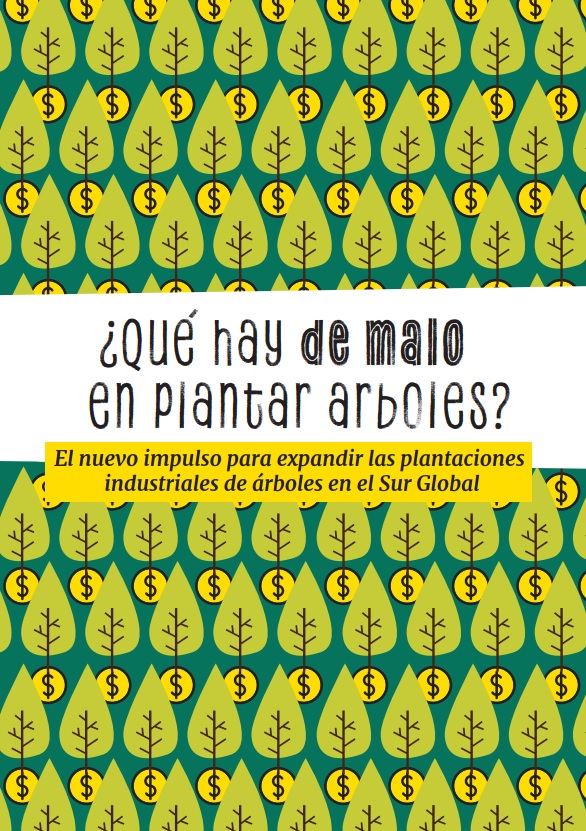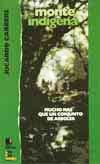As a condition to install its second pulp mill, the company UPM demanded that the Uruguayan government build a new railroad from the site where UPM plans to locate its mill to the port. The government would cover the costs of these infrastructure projects at the service of UPM.
The infrastructure of a country or region is key for extractive neocolonialism in countries in the Global South. Companies study and strategically select the places where it is most profitable to set up their operations; in so doing they take into account local unemployment, limited local organized opposition and national/regional legislation that is favorable to their interests, among other things. All this is in detriment to the quality of life of inhabitants and the environment.
For pulp companies that already have large areas of pine and eucalyptus plantations—as in the case of Uruguay—infrastructure is what makes the installation of a mill viable or not. Companies need a road network to ensure transport of the wood from the plantations to the mill, and the subsequent transport of the pulp produced to points of exportation to international markets.
In a secret agreement with the Uruguayan government, Finnish company UPM demanded a series of requirements as indispensable conditions to decide whether it will install its second mill in the country—the third pulp mill in Uruguay (1). Among these requirements is the construction of a new railway between the site where UPM plans to locate its new mill (in the center of the country) to the port of Montevideo—covering a distance of almost 300 km.
When the agreement between UPM and the government was made public, the details of the infrastructure projects that the Uruguayan government had committed to carrying out at its own expense became known. In addition to the million-dollar railway project, the government will assume the design, construction and maintenance of: a “Port Project,” an exclusive port for UPM’s pulp and derivatives (chemical products, forest products, etc.); the necessary dredging of the canal connecting the La Plata river and the dock adjacent to the UPM port terminal; a “Viaduct Project” to facilitate the crossing of the railroad with the port watercourse and to provide uninterrupted access to the trains carrying UPM cargo to the port; and “Roads Projects,” which include the renovation of roads apt for 48-ton semi-trailers and triple trailer trucks and the reinforcement of bridges in UPM’s area of influence in the center of the country (2).
These projects will cost more than double what the government originally announced. The Uruguayan people’s investment will practically double that of the company. In this way, the historical colonial pattern is repeated: while the transnational company obtains the most beneficial conditions for its business, the people go into debt to carry out construction projects that do not respond to their interests. On the contrary, these projects enable the expansion and profits of an extractive industry that increases the area of tree plantations, expels the rural population, consumes and contaminates soils and waterways and does not generate the jobs promised.
Although the Uruguayan government tries to justify its decision by stating that UPM’s second mill will create thousands of jobs—including through indirect job creation—the company only mentions 300 direct jobs at its facilities for the project (including workers at the UPM2 mill, workers at the chemical plant and maintenance workers) and 100 jobs at companies that provide services such as food, cleaning, security, etc. (3)
The Uruguayan government’s policy of openness to foreign investment, its desperate race to fully comply with UPM’s demands on time, and statements by government representatives across the media lead one to believe that these megaprojects have the full support of citizens. However, opinion within Uruguayan society is divided; and as the details of the agreement and these ventures come to light, a greater number of people question both the legality and content of the agreement, as well as the infrastructure and pulp mill projects.
There is hope to be found in the painstaking work, and the strengthening of different organizations and citizen initiatives that aim to show what is happening. They are denouncing the impacts, informing the population, defending the rights of citizens, and above all, rejecting this new form of colonialism.
(Dis)information, the Government’s Strategy
When UPM’s intention to install its second mill in our country was announced in 2016, the President of Uruguay declared that: “the company will allocate four billion dollars, and Uruguay will have to invest one billion dollars” to meet UPM’s infrastructure requirements (4).
However, as the government went about its “duties” (developing terms of reference, receiving budgets, etc), that which social movements and organizations denounced from the beginning has come true: the real investment that Uruguay would be making is much larger—and the company’s is much smaller—than what was originally stated. So much so, that infrastructure costs are currently estimated at more than four billion dollars for Uruguay. Meanwhile, UPM will not invest more than 2.4 billion dollars, and it will be exempt from the vast majority of national taxes, due its locating and operating in a free trade zone (5).
In his statements to the press, the Minister of Transport insists that the new train will be “a train by and for Uruguayans,” referring to the transport of passengers and other freight that will be able to reach the country’s capital via the new railroad (6).
However, from start to finish, this infrastructure project responds to UPM’s demands. The more than 270 km of railroad starts at UPM’s port terminal, goes through the free trade zone in Pueblo Centenario where the UPM pulp mill will be installed, and ends up at Paso de los Toros—where UPM’s waste plant will be located. According to the agreement, Uruguay is obligated to allow UPM unrestricted access to the new railroad 24 hours a day, 365 days a year—starting from the date the pulp mill is completed. It is also obligated to guarantee at least six daily trips in both directions to transport pulp (mill <–> port), and one round trip per day for the shipment of chemical products to the mill (2).
Nothing would indicate that this railroad is meant for other uses. For the time being, the project does not have other cargo terminals, nor does it involve the logistics necessary to transport other kinds of goods along the route. Furthermore, existing passenger trains in Uruguay are not compatible with this new infrastructure. The project is so much in service to the company that both the people and the media call it “the UPM train.”
According to representatives from the Railroad Workers’ Union and the State Railways Administration (AFE, by its Spanish acronym), the machines that AFE has used so far to transport cargo and passengers will definitely not be able to run on the new tracks built for UPM (7). AFE provided a passenger service in small sections that ended on June 14th of this year, due to the start of construction for UPM.
Impacts of “The UPM Train”
The new railway will be built on the existing route, which dates back to the second half of the 19th century. At that point in time, most of the towns that one sees today along the route did not exist; many of them came into being because of the train stations. According to official data, around 38,000 people live within the area of influence of this project (8).
The project will affect people in several departments, with direct consequences such as the expropriation of their land or the impacts caused by the noise and vibrations, etc. While the proposed project would maintain the current railway embankment, it would involve dismantling the existing tracks to install adequate infrastructure to guarantee transit of freight trains 24 hours a day, 365 days a year. These trains are 800 meters long and have engines that can reach a maximum speed of 100 kilometers per hour (9).
A project of this magnitude, designed for the industrial transport of pulp and dangerous chemical products—such as caustic soda and sulfuric acid—should not pass through urban centers. An estimated 350,000 tons of sulfuric acid, caustic soda, fuel, limestone and salt will be transported annually between the port terminal and the plant (10).
The suspension of AFE’s passenger service to initiate construction for UPM affected some 1,300 people—mainly workers who used this service to commute daily between Montevideo and relatively nearby towns. The main advantage of this service for these users was the considerably lower cost of the ticket and the speed relative to the buses in the metropolitan area, as well as greater comfort (11).
For railroad workers, the UPM train marks the beginning of the end of the state railroad monopoly, opening the door to private companies that will use a railroad built with money from the Uruguayan people.
Infrastructure for what and for whom? The infrastructure projects of a country should respond to the needs of the people and not to the demands of foreign capital. In this case, the UPM project is not taking into account existing territorial studies, or norms within the framework of Uruguay’s Land-Use Planning Law.
Citizen Opposition and Constitutional Initiatives
UPM does not have social endorsement because the population is divided. There are those who want new jobs and dream of improving their quality of life, betting on promises from UPM and the government. And there are others who express their discontent, citing not only socio-environmental impacts, but—in the first place—the million-dollar investment that the country must make to ensure the company receives considerable benefits.
“On the Side of the Tracks” is a group of residents from Montevideo who will be affected by the UPM train. They are denouncing the impacts of the railway project, and defending the rights of people who live near the tracks along its route through Montevideo. They are taking action with human rights organizations, Parliament, Municipal Government authorities and the Ministry of the Environment, etc., denouncing all kinds of irregularities in the train approval process (12). They emphasize that the trains will travel at high speeds, which implies vibrations, noises and air pollution. “The trains are eight blocks long and will travel at 60-80 kilometers per hour; they have to travel at that speed because they have six hours to get from the Port of Montevideo to Paso de los Toros. If they take longer than six hours, they do not get paid. That is why it is fenced off with barriers; the barriers are not for the protection of people, but for the protection and transit of the train.” (13)
The Movement for a Sustainable Uruguay (MOVUS, by its Spanish acronym) has also been monitoring the infrastructure projects, analyzing and denouncing the different irregularities in the process and promoting public debate on the issue. This is despite the fact that the information given to the people has always been incomplete—shared only upon citizens’ requests for access to public information, or provided once actions have already occurred (14).
The group “NO to the UPM train,” made up of people who live in Municipality C of Montevideo, is pushing forward a constitutional initiative to ban passage of the UPM train through that urban area. To this aim, it must obtain the signatures of 15% of the people authorized to vote in the municipality.
Similar initiatives are underway in various localities along the railroad track, including: Santa Bernardina, Durazno, Florida, Sarandí Grande, 25 de Mayo, Progreso, Canelones, La Paz; and other localities are joining.
Many informative talks, promoted by civil society organizations, are taking place in different neighborhoods of the country. On June 14th, a demonstration took place at the Montevideo train station, in recognition of the last passenger train that will travel for now, and for at least three years while construction for UPM is underway.
In June of this year, the “National Coordination of Social Organizations Against UPM” was formed to bring together the different social organizations that oppose the new mill.
The Coordination’s first action was to deliver a letter to the Honorary Consul of Finland in Uruguay, in order to let the Finnish government and citizenry know that there is growing social opposition to the UPM project in Uruguay. “This project agreed upon between UPM and the Uruguay’s executive branch – in an arbitrary and unconstitutional manner – constitutes a serious attack on the sovereignty, the environment, and human rights in the country,” denounced the organizations. “As inhabitants of this territory, we consider ourselves seriously affected in our legitimate rights and interests and we will appeal to all possible instances so that UPM2 is not carried out. For this reason, we make this call to the Finnish government and the UPM company to cease and desist from this megaproject,” the letter concludes (15).
Lizzie Díaz, lizzie@wrm.org.uy
Member of the WRM Secretariat
Source: WRM’s Bulletin Nº 244 – July 2019
1.- http://www.guayubira.org.uy/
2.- https://medios.presidencia.
3.- http://www.mvotma.gub.uy/
4.- https://www.elpais.com.uy/
5.- https://www.sudestada.com.uy/
6.- https://www.elpais.com.uy/
7.- https://www.busqueda.com.uy/
8.- http://www.radio36.com.uy/
9.- https://www.sudestada.com.uy/
10.- https://www.busqueda.com.uy/
11.- https://www.sudestada.com.uy/
12.- https://www.facebook.com/
13.- http://zur.org.uy/content/por-
14.- https://www.facebook.com/
15.- http://www.guayubira.org.uy/

